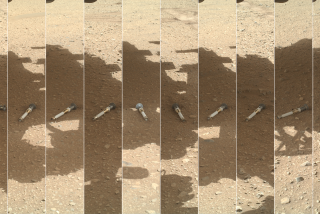Spacecraft Selected for Mars Mission
- Share via
An innovative spacecraft named Phoenix that resurrects pieces of NASA’s failed 1999 Polar Lander and its canceled 2001 Mars Surveyor Lander has won the competition to explore the Red Planet in 2008, NASA announced Monday.
The $325-million Phoenix lander is scheduled to be launched in 2007 and should arrive on the icy northern plains of Mars in May 2008. It will use a robotic arm that will act like a backhoe and dig a trench about three feet below the Martian permafrost in search of liquid water and environments suitable for life in the past or present.
“Our mission has the power to change our entire thinking about life in the solar system,” said Peter Smith, a University of Arizona planetary scientist and the lead scientist for the mission.
NASA selected Phoenix from four competing “scout” missions that had been winnowed from a pool of 23 proposals. Phoenix is the winner of NASA’s first Mars mission competition -- an initiative to foster the development of ideas in the scientific community for future missions. The agency plans to hold the competition every four years.
The Phoenix mission will borrow some of its design and exploration goals from the ill-fated Mars Polar Lander, which is believed to have crashed on Mars in 1999, and the Mars Surveyor Lander, which was canceled shortly after the loss so officials at NASA could rethink the Mars exploration program.
Smith said that Phoenix is “a rise from the ashes” of those other missions.
“We’ve refurbished those missions to be ready to fly again,” he said. “We think that they didn’t die, they just needed to be resurrected.”
Phoenix -- which will be managed, designed and built by the University of Arizona, NASA’s Jet Propulsion Laboratory in Pasadena and Lockheed Martin Space Systems in Denver -- will house a stationary robotic laboratory that will allow scientists to chemically examine the Martian soil without returning samples to Earth.
By using the robotic arm to scoop up soil samples and return them to the body of the lander, scientists can analyze the samples, looking for signs of organic materials and clues that Mars used to be warmer and wetter.
“If there is an overall objective for the program it is to assess Mars as a potential habitat either in the past, present or future for life,” said Firouz Naderi, JPL’s Mars program manager. “When looking for the predecessor of life, look where water could be.”
Other instruments on the lander will heat the samples to release water vapor and carbon dioxide, and mix distilled water with the soil to determine if its chemical makeup could sustain life of some sort.
The mission targets Mars’ northern plains, a region where the Mars Odyssey orbiter has already found tantalizing signs of abundant near-surface water ice.
The orbiter, now circling the Red Planet, has beamed back data fueling suspicions that these plains harbor a volume of up to 80% water ice just a foot below the surface.
“The significance of this [mission] is that we have this whopping ice signal up there in the northern plains of Mars and it’s beckoning,” said Jim Garvin, NASA’s lead scientist for Mars exploration. “We’re responding to this call by going there and landing.”
NASA launched two rover missions to Mars earlier this year. Spirit and Opportunity are scheduled to land on the planet in about January. The Phoenix mission is projected to cost less than half of the $800 million for the two rovers.
The competition that selected Phoenix attracted proposals from scientists at universities, government and industrial laboratories and aerospace firms.
The three missions that did not survive the final selection process include a spacecraft designed to swipe a sample of the Martian atmosphere and return it to Earth, an airplane intended to fly about a mile above Mars and study its near-surface atmospheric chemistry and an orbiter equipped with a spectrometer to map out the chemical composition of the Martian atmosphere and to look for recent volcanic activity.






